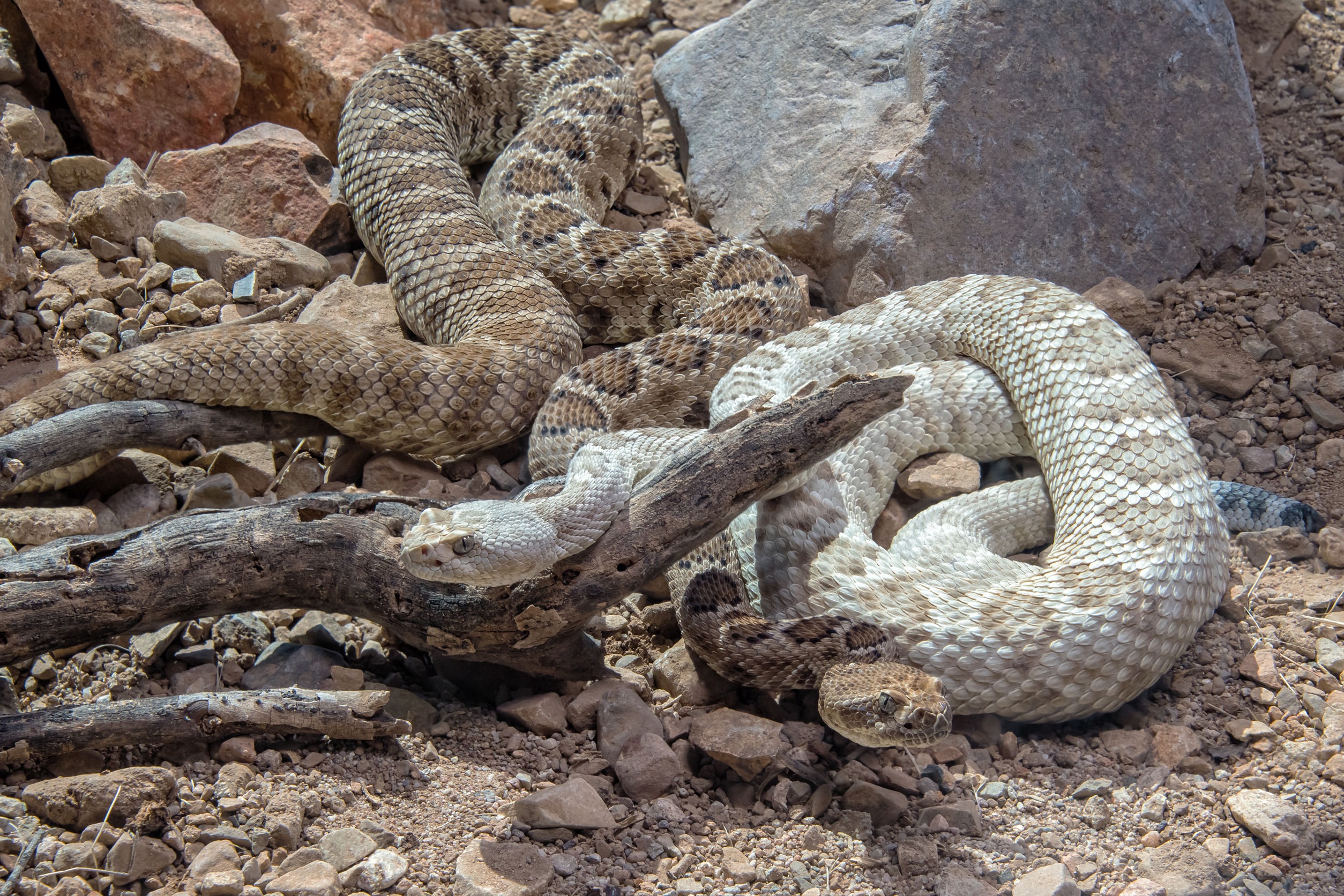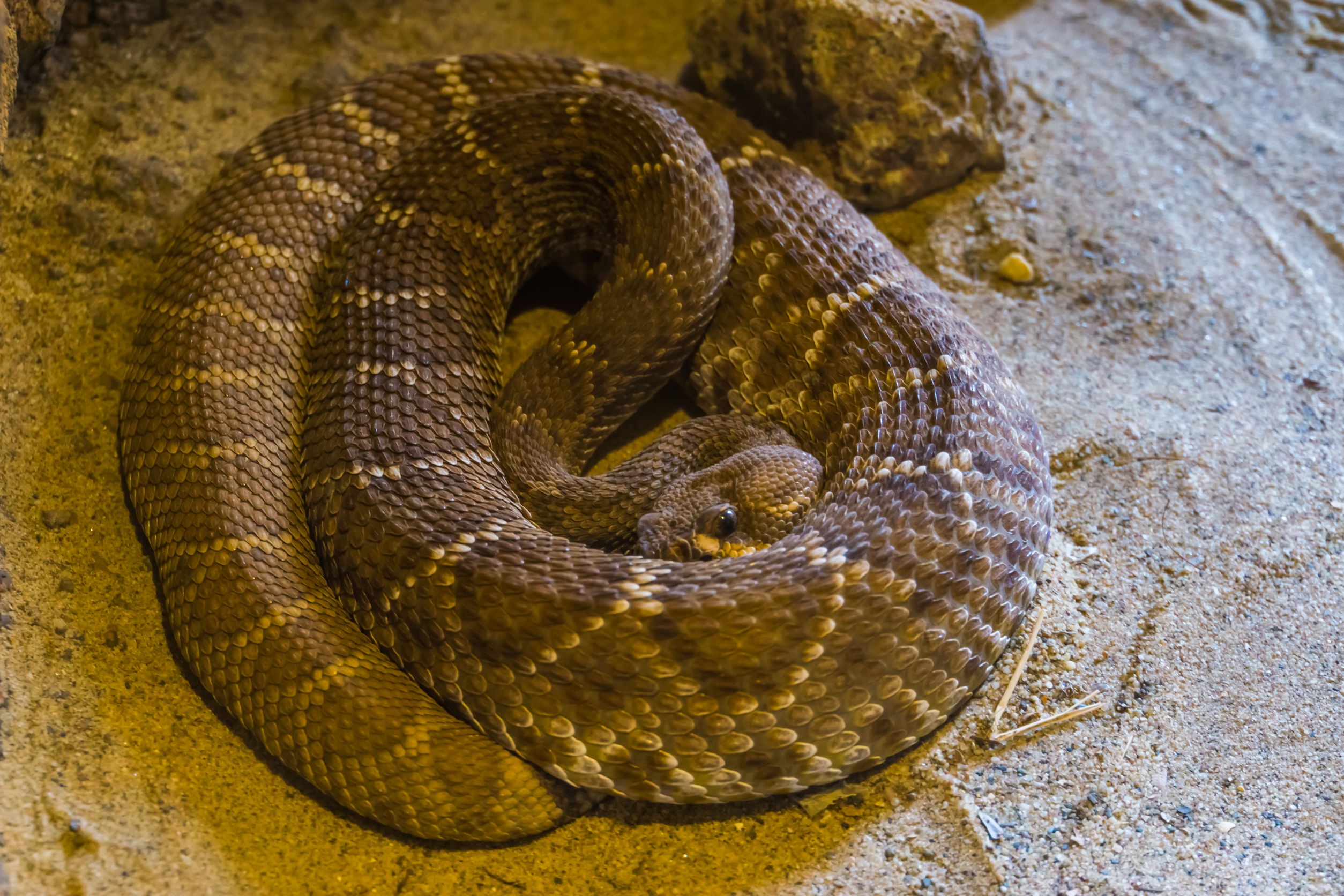
Rattlesnakes are incredibly common in the American Southwest with 32 official species of rattlesnakes. Most people have never seen a rattlesnake being born because they’re hidden and fiercely protected by their mothers. So how do rattlesnakes mate?
Here’s what I’ve learned over the years:
Rattlesnakes reproduce sexually by a male inserting his hemipenis into a female’s cloaca. After about 90 days, the female rattlesnake will give birth to a soft-membraned sac containing 4-10 live young.
Most rattlesnakes mate annually during the spring or early summertime.
That’s right, rattlesnakes don’t lay typical eggs; they give birth to live young wrapped in a sac or thin, transparent membrane. Many people have never (and will never) observe this reproduction and birthing process, so it seems like a mystery.
Below, we’ll cover the time of year when rattlesnakes mate, the process, and how babies are born.
What Time of Year do Rattlesnakes Mate?
Rattlesnakes can mate in spring, summer, or fall, or multiple times a year, depending on the species. But May through July is the most common months.
Why? Like many other animal species, rattlesnakes usually brumate (very similar to hibernation) during the winter. After all, they are cold-blooded creatures so they don’t do well in cold temperatures.
To stay warm, hundreds of rattlesnakes will huddle together underground to wait out the winter months. Rattlesnakes have often been observed cohabitating with other reptiles and even small mammals during the winter.
Come springtime, they’ll begin to emerge from their dens and begin looking for both a meal and a mate. As temperatures rise, they’ll be able to roam around outside for longer periods of time.
What is the Mating Process for Rattlesnakes?
A rattlesnake’s mating ritual is when a female releases pheromones from her body that leave a scent for males to follow. A male rattlesnake tracks a female’s scent using his tongue and Jacobson’s organs. Females can mate multiple times each mating season, but will only give birth about once every 2 or 3 years.
So, the pheromones are how she lets the guys know she’s “available.”
And Jacobson’s organs are olfactory (smell) sensing organs located in the roof of the mouth (humans have them too)! Rattlesnakes flick their tongues to pick up scent-bearing particles and deposit them on Jacobson’s organs. Rattlesnakes have a very keen sense of smell and it serves them well in many situations.
Rattlesnakes reach sexual maturity when males are 4-6 years old and females are 7-13 years old. However, there is no hard and fast rule for the age of sexual maturity since it can vary by species and location. In some areas, females reach sexual maturity at 5-6 years
If two male rattlesnakes meet while tracking the same female, they’ll typically engage in combat to fight over who gets to mate with her. People often confuse the sight of two male rattlesnakes fighting with a male and female doing a mating dance.
The easiest way to tell the two rituals apart is this: when male rattlesnakes are fighting over a female, they’ll lift themselves partway off the ground and wrap themselves around each other. They will then begin to wrestle, twisting together as they try to knock each other to the ground.
A wrestling match like this can last as short as several seconds or as long as several minutes, but in the end, whichever male wins the fight gets to mate with the female.
The loser generally slithers off at this point.
You may be wondering why the male snakes don’t just bite each other – after all, their poison is pretty effective, right? They are actually very social animals and won’t bite each other on purpose.
Many animal species display a similar kind of “rutting” behavior: the fighting and fancy moves are meant to intimidate the opponent and show who’s the toughest. The point is to establish dominance, not to injure or kill.
Check out the video below to see a real-life example of two male Western Diamondback rattlesnakes engaged in combat!
Now that the victorious male has won, he can try to woo his lady friend. In contrast to the wrestling match between two males, a mating dance between a male and a female rattlesnake involves the snakes remaining prostrate on the ground rather than lifting themselves off of it.
The male will try to attract the female’s attention by doing a sort of “twitchy,” “jerky” little dance that involves him moving his head, getting close to the female, and nudging her body.
He will also flick his tongue and flip his tail. If the female decides she is interested, she will generally flick her tongue and flip her tail too to let the male know they can move on to the next step.
Take a look at the video below to see what this mating dance looks like!
At this point, the male rattlesnake will twist his body around the female and position his cloaca close to hers. The cloaca is an opening near the end of a snake’s tail where both waste and reproductive fluids leave/enter the body.
Then, the male inserts his hemipenis (an organ male snakes have that is essentially a forked penis) into the female’s cloaca and deposits sperm. This process can last for several minutes or up to several hours. A female rattlesnake may also mate with more than one male during the mating season because of an ability that we’ll discuss in the next section.
What is the Rattlesnake Gestation Period?
Unlike most animals who reproduce sexually, female rattlesnakes can choose whether to become pregnant or not after mating. They can store sperm in a special chamber in their bodies for up to five years. During that time, a female can choose when she wants the sperm to fertilize her eggs.
This is why one female rattlesnake can mate with several males and not give birth for a year or more afterward. When she chooses to let the stored sperm fertilize her eggs, she will become pregnant and give birth to a litter of babies from multiple fathers.
Here’s a fact you may not have known:
Most snakes are oviparous, which means they lay eggs, but rattlesnakes are ovoviviparous, which means they give birth to live young. Baby rattlesnakes will gestate in eggs inside their mother’s body, but then hatch while still inside her. When it’s time for them to be born, they’ll exit their mother’s body as fully-developed, albeit small, snakes, coated in a clear membrane.
The gestation period for most rattlesnakes is between three-seven months, depending on the species. Even though a female rattlesnake is only pregnant for about three months, she only gives birth once every two to three years.
What is the Rattlesnake Birthing Process?

Female rattlesnakes can carry up to 25 eggs inside of them at a time, but only about 4-10 per brood are ever born alive. A female rattlesnake will often gestate in a sheltered location underground. Her young will be safe from predators and have access to rodents for their first meal.
As mentioned before, when her babies are ready to be born, the female will give birth to her live young through her cloaca.
They usually emerge encased in a clear membrane, much like the amniotic sac found in many mammals, but quickly break free. Newborn rattlesnakes are already quite developed. They are about 10 inches long, with fangs, venom, and a little button on the end of their tails where a rattle will eventually develop.
Every time they shed their skin, rattlesnakes’ rattles gain a segment.
A baby rattlesnake’s “button” doesn’t make noise, which is one reason they are so dangerous. Although they possess less venom, it is slightly more toxic than an adult. And since they can’t be heard, you may get too close to one before you see it and it may strike.
After about a week, a mother rattlesnake leaves her babies to fend for themselves. She has no way to feed them, so they must become self-sufficient.

Differences Among Other Rattlesnake Species
While all rattlesnakes typically behave the same way, there are some differences in the mating process among different species. Rattlesnakes also get started on their own pretty early in life.
Geographical Regions
A snake’s mating habits may differ based on where it lives.
Rattlesnakes are native to the Americas and are found most prevalently in the American Southwest and Mexico. Nevertheless, they are pretty hardy reptiles and can withstand a variety of conditions.
Species that live in more southern regions, such as the western diamondback rattlesnake, tend to mate when they come out of hibernation in the springtime. Northern-dwelling rattlesnakes, such as the eastern massasauga rattlesnake, mate in autumn, and the female can store the sperm in her body until she’s ready to be pregnant in the spring.
Gestation and Birth
Though most female rattlesnakes gestate for about 90 days, there are some species whose pregnancies are a little different.
Take the timber rattler, for example. This snake can be pregnant for up to about five months. It is also one of the more passive, slow-moving species of rattlesnake, so you might not see these northern-dwellers as often. They’re excellent hiders.
More interesting behavior comes from the Arizona black rattlesnake. Unlike most rattlesnakes, when females of this species give birth, they often stay with their young in the nest for several weeks after they are born. Mothers can even be seen cooperatively parenting their litters. This behavior is much more reminiscent of that of mammals.
Brumation
Winter dormancy also plays a part in a rattlesnake’s reproductive behavior. Rattlesnake species that do not brumate during the winter tend to reproduce more often than species that do brumate.
For example, the lance-headed rattlesnake, native to Mexico, does not need to brumate and reproduces annually. The timber rattlesnake, on the other hand, lives in the mountains of New England. This snake does brumate during the winter and only reproduces once every three years.
Can You Tell if a Rattlesnake is Pregnant?
It is sometimes possible to tell that a female rattlesnake is pregnant as they may be bulkier in the abdomen. However, this could also mean that the snake has just eaten a large meal though.
But really, it’s hard to tell if a rattlesnake is pregnant. That’s especially true in the wild and if you’re keeping a safe distance.
Differences Between Male and Female Rattlesnakes
First, let’s explore the visual differences between male and female rattlesnakes. Though it’s impossible to visually sex a snake with 100% accuracy, certain features make differentiating them a lot easier.
Male rattlesnakes usually have thicker and longer tails than females do.
Their tails also tend to taper gradually from their body. Female rattlesnakes generally have thinner, shorter tails that narrow abruptly, rather than gradually. It has been noted that females tend to have a harder time folding their tails in on their bodies because of this, which may be another visual clue.
Again, the only way to truly know whether a rattlesnake is a male or a female is to handle the specimen and probe for hemipenes. This is NOT recommended, though. Do not try to handle a rattlesnake, unless you’re a professional researcher.
Can You Identify a Pregnant Rattlesnake?
It is not very likely that you’d be able to visually recognize a pregnant rattlesnake, especially if you are observing from a safe distance. Experts who regularly handle rattlesnakes have more behavioral clues that can help them determine if a female is pregnant or not.
For example, many female rattlesnakes will stop eating as much, or stop eating at all, while they are pregnant.
Before you get too concerned, remember an adult rattlesnake doesn’t need to eat nearly as often as an adult human. They only need to eat once every 1-2 weeks as opposed to three times per day and can go as long as 6 months without a meal.
The only way to know for sure if a rattlesnake is pregnant though is to handle her and be able to observe her for longer periods of time than most curious onlookers could, or should.
